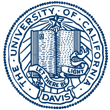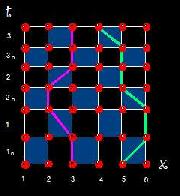
This REU program was funded through NSF PHY-0243904.


(Students' names link to their final papers. There are some formatting problems, particularly with figures, but you can still get a lot more detail about the projects from them.)
Condensed Matter Experiment
Melina Blees (Carleton College; advisor Kai Liu) made cobalt wires, 200 nanometers in diameter, by pulsed electrodeposition. To test the samples, she measured resistance as a function of applied magnetic field, finding a sharp difference when the field is perpendicular or parallel to the wires. This observed magnetoresistance confirmed that the fabrication process was successful. The next step in the work will be to make wires with layers of copper and cobalt interspersed. The magnetic moment of a thin cobalt layer may be used as a memory bit. Magnetic scattering depending on the cobalt's moment would affect the wire's resistance. The key advantage of the technique is that an applied current might be used both for reading the magnetization and for switching it, with ultimate applications in magnetic recording technology.
Anna Smith (Seattle University; advisor Rena Zieve) worked on a variety of tasks related to studies of vortex motion in superfluid helium. She began by fabricating experimental cells: preparing fine wires for the measurements, stretching each along the axis of a long cylinder, gluing it in place, and checking for leaks. Later she wound a spare superconducting magnet for the experiments. It proved necessary before the end of the summer, and Anna installed it on the refrigerator. Anna also worked on computer models of a moving vortex, both running lengthy simulations and writing a companion program to make the main simulation code easier to debug.
Bryce Kalmbach (University of Washington; advisor Rena Zieve) measured the stability angle of a binary granular mixture in two dimensions. The two grain shapes were single spheres, and hexagons formed by welding seven of the spheres together. A homogeneous pile of hexagons reaches a much larger angle before avalanching than does a pile of spheres. Mixing a small fraction of spheres in with the hexagons sharply reduces the stability angle, while mixing a small fraction of hexagons in with the spheres has little effect. Bryce took careful measurements, investigating and eliminating various sources of noise. By using spheres and hexagons of different colors, he related the behavior of the stability angle to the tendency of the spheres to cluster near the center of the container, slightly below the surface of the pile. The strong effect of a few spheres added to a pile of hexagons suggests that this central region is key to triggering avalanches.
Condensed Matter Theory
Ben Heldt (Santa Clara University; advisor Sergey Savrasov programmed a Pade approximation technique to approximate functions. If a function is known on the imaginary axis, the technique finds the analytic continuation to the real axis, where the values may have a physical interpretation. The approximation depends on a weighted sum over the roots of a derived polynomial. As the number of known values of the function increases, so does the order of the polynomial. Ben found that the algorithm, while mostly effective, becomes unstable for very high order polynomials. A possible fix is to change the basis used to describe polynomials.
The Hubbard model describes electrons which are located at discrete, fixed sites and interact in several ways: through their spins, Coulomb repulsion, and the possibility of "hopping" from one site to another. Changing the various interaction strengths and occasionally adding additional interaction terms allow the model to help investigate different types of magnetism and even superconductivity. Helen Craig (American River College; advisors Warren Pickett and Richard Scalettar) wrote and ran code to calculate ground states for two variants of the Hubbard model. The goal was to construct a phase diagram by determining the ground state for different values of the interaction strengths. Helen found both charge and spin density wave phases in different regions.
Biological Physics
Scott Clark (Oregon State University; advisors Daniel Cox and Rajiv Singh) did a statistical analysis of the stability of different protein configurations. Since proteins are normally surrounded by water, the calculation assumes that some of the amino acids that compose the protein are hydrophobic and tend to point towards the inside of the protein, while others are hydrophilic and tend to point outwards into the water. These considerations determine how exactly the protein folds into a beta-helix. Scott's calculation estimated favorable positions for each amino acid, and approximated the volume of the resulting configuration.
A standard technique for tracking molecules in biological systems is attaching a fluorescent group, or fluorophore. Ideally the fluorophore has little effect on the original molecule's structure and function. Unfortunately, the label does sometimes disrupt protein function, and even measuring the degree of disruption is difficult. Andrea Herrick (Ohio Northern University; advisor Xiangdong Zhu) worked on an entirely non-invasive method for tracing reactions, by measuring slight changes in a solution's optical reflectivity. Andrea worked on setting up a new microscope, particularly writing software to control the microscope as it scans a microarray. Each microarray contains thousands of distinct compounds in isolated positions, and make possible an economy of scale when testing large numbers of possible reactions.
High Energy Experiment
Alessandra Borgia (SUNY Binghamton; advisor Mani Tripathi) ) worked on C.A.C.T.U.S., a ground-based gamma ray telescope using a former solar plant in the southern California desert. Alessandra worked on Monte Carlo simulations modeling the background noise from the night sky. Her Monte Carlo technique generated photon showers that would impinge on the detector. Next she used ray tracing to determine where each photon was detected, and compiled histograms of the photon distribution for different showers. The work confirmed the importance of cleaning the mirrors and highlighted the problem of diffuse light from the nearby town, military base, and airport.
Nuclear Physics
In an encounter between two relativistic heavy ions, many pairs of nucleons collide. Analysis of the result depends heavily on statistical calculations. Suzanne Pittman (San Joaquin Delta Community College; advisors Manuel Calderon de la Barca Sanchez and Daniel Cebra ) used the Glauber Model to estimate the number of expected collisions as a function of the nearest approach distance of the ions' centers. To relate the calculations to experimental results from Brookhaven's Relativistic Heavy Ion Collider, Suzanne then worked out the implications of her calculation for how many charged particles a collision would likely generate. She compared data from three experimental runs, one with known trigger inefficiency, and found that trigger efficiency has less effect on charged particle creation than expected.
Cosmology
Josh Lande (Marlboro College; advisor Tony Tyson ) wrote a computer model of the Deep Lens Survey. The survey attempts to locate dark matter in the nearby universe by noting its bending of light. The bending is observed as gravitational lensing, or distortions in the images that appear when the light reaches us. Josh generated artificial images of pieces of the sky, including the effects of gravitational lensing, the atmosphere, and noise. A next step is to compare the simulation and actual data, a way to uncover possible systematic errors in the real data.
